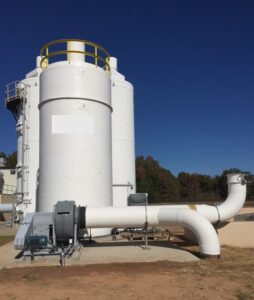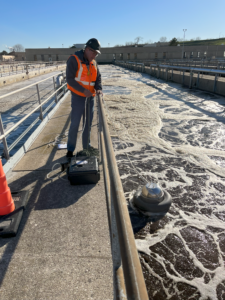How to Choose the Right Wastewater Odor Control System: A Step-by-Step Planning Guide
 Odor control in wastewater facilities isn’t just about public complaints. It affects daily operations, long-term planning, and regulatory compliance. Persistent odors can lead to permit violations, corrode infrastructure, and damage relationships with nearby communities.
Odor control in wastewater facilities isn’t just about public complaints. It affects daily operations, long-term planning, and regulatory compliance. Persistent odors can lead to permit violations, corrode infrastructure, and damage relationships with nearby communities.
At Webster Environmental Associates (WEA), we help facilities tackle these challenges by designing odor control systems that work in real-world conditions. Choosing the right system takes more than picking from a list of technologies. It requires understanding your site and how odors behave across your treatment processes.
Step 1: Identify Where Odors Are Coming From
Before you can fix an odor problem, you need to know where it’s starting. Most wastewater plants have several potential sources. These often include headworks, primary clarifiers, solids handling areas, and force mains. Each location can contribute different compounds to the overall odor profile.
Our team starts with on-site testing. We use both air and liquid sampling to measure key compounds like hydrogen sulfide and ammonia. We often include odor panel testing to get a full picture of how strong and noticeable the odors are. This early stage of evaluation gives us the data we need to recommend the right approach.
Step 2: Compare Technologies for Odor Control
There is no single best technology for every site. Choosing the right system depends on what kinds of odors you’re dealing with, how strong they are, and where they’re coming from.
Biofilters are a good option for steady airflows with organic odors. They use natural media and microorganisms to treat air without chemicals. They have low energy needs and are often easier to maintain long-term.
Chemical scrubbers are used when odors are stronger or more variable. These systems use acid or oxidizing chemicals to break down odor compounds. They work well in many situations but require more oversight and chemical handling.
Carbon adsorption systems are often used as a final polishing step. They’re effective for light odors or as backup units. However, carbon beds must be replaced when saturated, which adds recurring costs.
Some plants also treat odors at the source using liquid-phase additives. These include nitrate, iron salts, or hydrogen peroxide to reduce sulfide formation in the collection system. We help clients compare all of these technologies side by side.
Step 3: Consider Site-Specific Needs
 A system that works well at one plant might not be right for another. That’s why we always look closely at each facility’s layout, operations, and resources.
A system that works well at one plant might not be right for another. That’s why we always look closely at each facility’s layout, operations, and resources.
Do you have room for a large media bed, or is space tight? Do you have staff available for routine chemical refills, or would a passive system be better? Are power costs a concern? These are the kinds of questions we ask before recommending any specific technology.
Our designs always start with real-world constraints. We create odor control systems that match your actual needs—not generic systems that don’t quite fit. Whether we’re working on a new plant or updating older equipment, we focus on getting the setup right the first time.
Step 4: Plan for Operation and Maintenance
Once your system is installed, it still needs regular attention to keep working properly. This is where many odor control systems fall short—not because of poor design, but because maintenance was not part of the original plan.
Some systems require periodic cleaning, media replacement, or chemical refills. Others need monitoring to track performance and adjust settings over time. We help our clients build realistic maintenance plans based on system type, workload, and budget.
At WEA, we stay involved long after startup. We offer ongoing support to help you track system performance and respond to changes. If sulfide levels rise or airflow patterns shift, we can help you adjust the system before small problems turn into big ones.
Let WEA Help You Build a Smart, Reliable Odor Control Plan
Choosing the right wastewater odor control system isn’t just about picking a product. It’s about understanding your site, collecting the right data, and choosing a setup that matches your conditions and goals. At Webster Environmental Associates, we’ve helped hundreds of facilities work through this process.
We bring practical experience, clear communication, and proven methods to every project. If your plant is dealing with odor complaints, system wear, or planning an upgrade, we can help you take the next step with confidence.
Reach out to our team to schedule a site evaluation or consultation. We’re ready to help you build an odor control plan that actually works.
